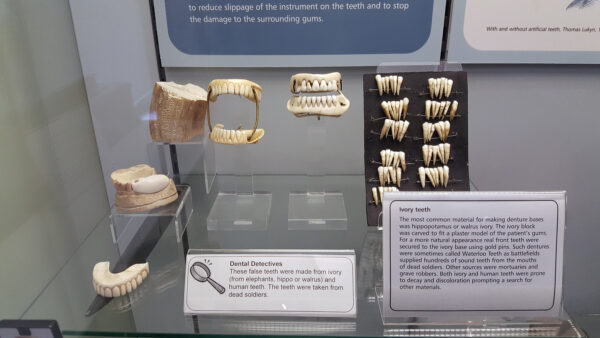Yes, all about teeth and toothache and pulling teeth and filling teeth and polishing teeth.
In my humble opinion some of the best museums are the ones that you probably never thought existed on a topic you often don’t think about that often, and yet when you hear there’s a museum about them, you want to visit it.
That they are often only open for a few hours a week weirdly makes them even more desirable.
Such is the British Dental Museum, housed in the head office of the British Dental Association, a short walk from Bond Street tube station.
Teeth are an odd thing though when you think about it.
Pretty much essential to survive, they are the source of unimaginable pain when they go wrong even though a good set of gnashers are seen as a sign of desirability, such that some people would sell their teeth to less dentally fortunate, if fortunately richer people.
And on top of all that, they need daily maintenance.
Yet for most of mankind’s history, they have been something that the medical profession have struggled with.
It wasn’t until the early 19th century that medical treatments started to emerge that were a bit more refined than using a pair of blacksmiths pliers to wrench teeth out, with the attendant damage that caused to the surrounding areas.
It was 1856 that the first Odontological Society was formed in London to promote dentistry as a profession, and in 1878 that the use of the term “dentist” was regulated by law, and the British Dental Association formed.
However, it wasn’t until 1921 that performing dental surgery was finally restricted to trained professionals.
Despite nearly a century of professionalism, a visit to the dentist is still something most of us dread, and a visit to a museum about dentists might be likely to evoke a shudder in people.
Yet, it’s really quite fascinating… in a room full of implements of torture sort of way.
In no particular order, the cabinets show off aspects of dentistry that feels familiar, yet the history seems most odd. Before ceramic teeth, most people who could afford replacements often wore dentures made from other people’s teeth.
A soldier fighting wars could earn a decent bit of cash taking the teeth from dead soldiers to sell back home. So commonplace was the habit that they became known as Waterloo teeth for one particularly productive battle, at least as far as teeth stealing was concerned.
The dentures themselves were often taken from animals such as walrus ivory or hippopotamus bone.
Animals also served in the fashioning of the first toothbrushes that we would recognise today, and the handles were often made from ox buttock bones. So yes, your Georgian ancestor cleaned their teeth with a cows bum.
Turns out that dental floss is rather older than I would have expected if you had asked.
Of course, it’s the equipment that usually sends people scurrying out of the room in horror. The drilling, grinding noises that take place inside the mouth, rather too close for comfort.
In a way, some dental operations are not that dissimilar to drilling and cutting bone in other parts of the body, except that we’re usually awake, and listening to the drilling sounds going on. Ugh!
Before electric drills there were the clockwork drills. The first invented in 1864 could work for 2 minutes before needing to be rewound. The noise it made was described as not causing discomfort to patients.
We have to remember that all this was going on before anesthetic, so people not only heard everything, they felt everything as well.
No wonder we fear a visit to the dentist, it’s centuries of fear passed down through our DNA.
However, you shouldn’t fear a visit to the museum. It’s quite fascinating.
The British Dental Museum is free to visit and open on Tuesday and Thursday from 1pm to 4pm. Entry is free.
If you want, they can open on other days – contact them if making a special trip. Don’t forget to smile when you go in.
















I reckon readers will be aching to pay this museum a visit…,!
Reminds me of visits to the school dentist.
Unhappy days!